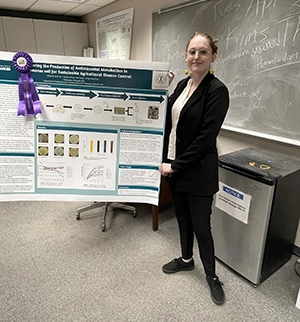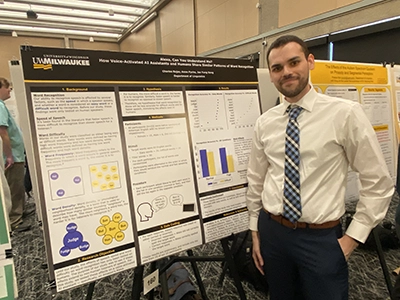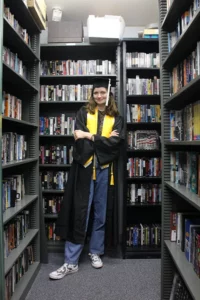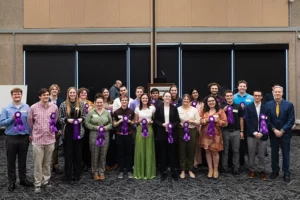The UWM Undergraduate Research Symposium is an annual event where student researchers from across the university can showcase the results of their work. At this year’s symposium in April, more than one hundred students presented on topics ranging from E-cigarette taxation to drug-resistant bacteria to Hispanic cultural history.
But several young researchers’ work especially stood out, including some from the College of Letters & Science. They were honored with Outstanding Presentation Awards at the end of the symposium for their hard work and dedication. Below are three L&S students who received awards, drawn from disciplines across the natural sciences, social sciences, and humanities.
Kelsey Sponholz, research in Biological Sciences – “Enhancing the Production of Antimicrobial Metabolites in Pseudomonas soli for Sustainable Agricultural Disease Control”
A few years ago, biological sciences major Kelsey Sponholz did not think she would even attend college, let alone participate in undergraduate research or earn an Outstanding Presentation award.
Instead, Sponholz was grappling with some mental health issues after high school and was reluctant to take on higher education: “I didn’t want to do it. It was scary. Not going to do it. Can’t do it.”
She did it. Standing in her graduation robe at Commencement in May, Sponholz felt “it was really exciting. It was a wonderful reflection on what I’ve done and how far I’ve come.”

Part of that journey was working as an intern for T3 BioScience, a company founded by UWM Professor of Biological Science Ching-Hong Yang. Yang’s primary focus is on combatting fire blight, a disease that targets fruit trees and like apple and pear trees. Left unchecked, fire blight can wipe out entire orchards. The disease is caused by a bacterium that has grown increasingly resistant to clinical antibiotics like streptomycin, which is commonly used to treat infected trees.
Yang has found that a different strain of bacteria, called Pseudomonas Soli T307, produces an antimicrobial compound that has proven effective in inhibiting fire blight. The compound is called RejuAgro A (RAA), and it was Sponholz’s job to identify ways to improve RAA production.
“We induce mutagenesis using chemical treatments, which cause changes in the genetic code similar to natural evolution,” Sponholz explained. “We now have a couple of different strains of P. soli that increase RAA production. Our goal is to understand how these mutations result in higher RAA production.”
She tests the bacteria’s RAA-producing abilities by observing how a certain strain affects the growth of the pathogen that causes fire blight. If a strain performs well, the researchers know they’re on the right track.
Although this is an admittedly slow method, it provides a rich inventory of improved bacterial strains and valuable insights into the metabolic mechanisms of RAA production and regulation by analyzing the genetic codes in these mutants. Additionally, other researchers in Yang’s lab are working to sequence the P. soli genome to pinpoint which genes are responsible for RAA production. That project will take time, however, so Sponholz is using the old-fashioned trial-and-error method in the meantime.
And it has yielded results; Sponholz and other researchers have identified several “mutant” strains that produce more RAA than the original P. soli strain.
That’s important because “this is going to become a commercial product for farmers to use,” Sponholz said. “The USDA is providing a lot of funding for this project. Our base strain produces a maximum amount of metabolite that we can package easily, but it’s a very finite amount we can get from one batch. … The goal is to have another strain where we can get more of this product out of each batch.”
Sponholz presented her research at the symposium in April. She was happy to win the Outstanding Presentation award, but “I think the more exciting part was when I got to tell Dr. Yang about it. He was so excited and it made me even happier,” she laughed.
Now that she has graduated, Sponholz plans to move to the west coast and take a few years off from school before pursuing a graduate degree.
Charles Rojas, research in Linguistics – “How Voice-Activated AI Assistants and Humans Share Similar Patterns of Word Recognition”
Charles Rojas’ research mentor, Jae Yung Song, warned him to temper his expectations for his first Undergraduate Research Symposium.
“She knew how excited I was and she didn’t want me to feel too down on myself if I didn’t win,” Rojas said with a smile. “I ended up winning and we were both just so excited and so happy. It made me feel like all my hard work was being recognized.”

Rojas has worked harder than most. He is a nontraditional student seeking his second Bachelor’s degree after earning his first at UW-Madison in 2019. He is a program assistant working in the Geosciences Department as he works on his Spanish major. And earlier this year, he reached out to see if Song needed a research assistant, since he is particularly interested in learning about language acquisition.
She did, and she wanted to study the language acquisition of an unusual subject: Alexa, the AI assistant powered by Amazon.
“AI is created by humans, but it still learns in a different way than we do,” Rojas explained. “It doesn’t have different parts of a brain focusing on language like humans do. How does AI learn a language? Does it make the same errors that humans do?”
Humans, Rojas explained, have several weaknesses when it comes to word recognition. It is more difficult to recognize words if a speaker is talking quickly versus normally or slowly. We have an easier time recognizing high-frequency words, or words that occur often in everyday speech. We struggle if a word has high density, meaning that a word sounds similar to a variety of other words. For example, the word “bun” sounds similar to “bus,” “sun,” “run,” “but,” and so on, because they all differ by just one phoneme. The word “bun” would therefore be considered a high-density word. A low-density word like “fudge” only has a few phonological neighbors.
To test whether Alexa had the same hang-ups, Rojas and his colleagues set up some word-recognition tests for the AI software. They had 21 different human participants ask Alexa to spell a list of 150 words. If Alexa spelled the word correctly, they knew it had recognized the word. If it was spelled incorrectly, the AI had failed its recognition. The readers read the list of words twice, at a normal speaking pace and at a quick pace.
How did Alexa do?
“Her patterns of word recognition mimic humans very much,” Rojas said. “She struggled a lot with difficult words, meaning they were low-frequency and high-density. She struggled even more with difficult words at a fast-speaking rate condition. … In other words, she produced the same errors that we do, and it was very interesting to see that Alexa pretty much learns language how humans do.”
This knowledge is important because language recognition is a crucial tool for AI software. It can be used to translate foreign languages, or to help disabled people communicate.
“I use my voice-activated AI system for a lot of different things,” Rojas said. “It would be great if didn’t get confused between two different words from time to time because it struggles with the same word recognition patterns that we do.”
Rojas plans to graduate in 2026. In the meantime, he’s eager to continue with his undergraduate research.
Ashley Hale, research in Film Studies – “Research in the Film Studies Media Collective”
Ashley Hale was not expecting to receive an Outstanding Presentation Award for her oral presentation about her work in the Film Studies’ archive.
“I thought, I’m not a STEM major. They’re not going to give it to a (humanities) major. And then I did win. … That was really cool,” Hale said with a smile. “I think when people think of research, they think of people in a lab coat. You don’t have to be that if you want to do research. I wanted people to see how valuable work in the humanities is and how it can be applicable to a lot of careers.”
And so, she showed them. Hale’s presentation focused on her work within the Film Studies Department’s media archive, which houses a library of films and other materials available for use by faculty, staff, and students. Over the course of her time, she completed four major projects, which she detailed in her symposium presentation.

- Librarianship – cleaning up media
When Hale, a film studies and English double-major, began working the archive, the collection was disorganized and hard to use. Hale combatted the chaos by inputting books and film into online databases, cataloguing magazines, and alphabetizing much of the collection. She and a graduate student also explored the archive’s VHS collection, eliminated duplicate tapes, and began digitizing the collection.
“I had to relearn how to use a VHS player,” Hale joked. “Then I had to learn how to handle some of our older media like the laser discs – I learned what a laser disc is, too.”
- Creating a lending library
The archive is home to many books as well as films, and Hale wants faculty and students to be able to check them out of the collection. To do that, she organized the haphazard stacks of books, magazines, and journals and created an online finding aid called “Library Thing” so that users can search for the materials they’d like to borrow. Hale also applied her methods to organizing films so that professors can easily request materials for their classes, and the student archivists can gather up their course materials at the beginning of the school year.
- Organizing the Father Gene D. Phillips Collection
“One day I was in the archive and I found these boxes in the corner,” Hale recalled. “I opened them up and it’s this collection of letters and books and film stills that was donated to the UWM Film Studies program from Rev. Gene Phillips who was a professor at Loyola University.”
Among the materials were correspondence between Phillips and industry legends, like Stanley Kubrick, George Cukor, and Mary Hemingway (wife of Ernest Hemingway). Hale sorted through the materials, alphabetized them, sorted them by decade, and has been labeling the film stills – there are more than 500 from films by Alfred Hitchcock, Charlie Chaplin, and others. She’s also entered them into the archive’s online finding aid so they can be easily searched.
- Film Studies program oral history
The Film Studies program celebrates its 50th anniversary next year. Hale and other students have been interviewing past and present faculty members about their experiences with the program, how it has evolved over the years, and how it brings value to students and the university.
“I felt really honored to just talk to a lot of film scholars that I admire,” said Hale. “We’ve collected some really cool interviews.”
Hale has had to leave her projects in other hands; she graduated in May and plans to take some time off before she heads back to graduate school.
Other Outstanding Presentation award winners from the College of Letters & Science include Preston Burdett (Chemistry), Nathan Ebersole (Psychology), Jessica Kania (Psychology), Terra Johnson (Geosciences), Liam Farin (History), Florin Saitis (Biological Sciences), Nicholas Richards (Psychology), Harleen Tewatia (Biological Sciences), Aniket Singh (Mathematical Sciences), and Amelia Scheiber (Biological Sciences).
By Sarah Vickery, College of Letters & Science
